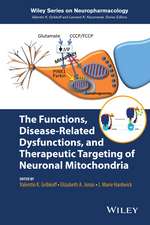Neural Substrates of Memory, Affective Functions, and Conscious Experience: Advances in Anatomy, Embryology and Cell Biology, cartea 166
Autor C. Loeb, G. F. Poggioen Limba Engleză Paperback – 20 aug 2002
Din seria Advances in Anatomy, Embryology and Cell Biology
- 5%
 Preț: 1146.33 lei
Preț: 1146.33 lei - 5%
 Preț: 721.19 lei
Preț: 721.19 lei - 15%
 Preț: 637.13 lei
Preț: 637.13 lei -
 Preț: 381.81 lei
Preț: 381.81 lei - 15%
 Preț: 644.95 lei
Preț: 644.95 lei - 5%
 Preț: 1025.16 lei
Preț: 1025.16 lei - 15%
 Preț: 689.97 lei
Preț: 689.97 lei - 15%
 Preț: 577.07 lei
Preț: 577.07 lei - 15%
 Preț: 580.36 lei
Preț: 580.36 lei - 5%
 Preț: 393.51 lei
Preț: 393.51 lei -
 Preț: 408.66 lei
Preț: 408.66 lei -
![Die Schlüpfdrüse der Geburtshelferkröte (Alytes o. obstetricans [LAURENTI]) und anderer Froschlurche](https://i4.books-express.ro/bs/9783662239742/die-schluepfdruese-der-geburtshelferkroete-alytes-o-obstetricans-laurenti-und-anderer-froschlurche.jpg) Preț: 408.27 lei
Preț: 408.27 lei - 5%
 Preț: 1090.61 lei
Preț: 1090.61 lei - 5%
 Preț: 705.11 lei
Preț: 705.11 lei - 5%
 Preț: 706.04 lei
Preț: 706.04 lei - 5%
 Preț: 357.61 lei
Preț: 357.61 lei - 5%
 Preț: 704.59 lei
Preț: 704.59 lei - 5%
 Preț: 705.11 lei
Preț: 705.11 lei - 5%
 Preț: 359.42 lei
Preț: 359.42 lei - 5%
 Preț: 711.52 lei
Preț: 711.52 lei - 15%
 Preț: 635.47 lei
Preț: 635.47 lei - 15%
 Preț: 631.72 lei
Preț: 631.72 lei - 15%
 Preț: 633.35 lei
Preț: 633.35 lei - 15%
 Preț: 632.37 lei
Preț: 632.37 lei - 5%
 Preț: 706.60 lei
Preț: 706.60 lei - 15%
 Preț: 631.07 lei
Preț: 631.07 lei - 5%
 Preț: 707.13 lei
Preț: 707.13 lei - 5%
 Preț: 707.33 lei
Preț: 707.33 lei - 5%
 Preț: 359.60 lei
Preț: 359.60 lei - 5%
 Preț: 707.69 lei
Preț: 707.69 lei - 5%
 Preț: 707.13 lei
Preț: 707.13 lei - 5%
 Preț: 708.06 lei
Preț: 708.06 lei - 5%
 Preț: 706.41 lei
Preț: 706.41 lei - 5%
 Preț: 708.78 lei
Preț: 708.78 lei - 5%
 Preț: 705.68 lei
Preț: 705.68 lei - 5%
 Preț: 705.11 lei
Preț: 705.11 lei - 5%
 Preț: 706.77 lei
Preț: 706.77 lei - 15%
 Preț: 635.15 lei
Preț: 635.15 lei - 15%
 Preț: 631.07 lei
Preț: 631.07 lei - 5%
 Preț: 706.77 lei
Preț: 706.77 lei - 5%
 Preț: 706.04 lei
Preț: 706.04 lei - 5%
 Preț: 710.79 lei
Preț: 710.79 lei - 5%
 Preț: 705.32 lei
Preț: 705.32 lei - 15%
 Preț: 633.19 lei
Preț: 633.19 lei - 15%
 Preț: 629.09 lei
Preț: 629.09 lei - 15%
 Preț: 633.53 lei
Preț: 633.53 lei - 15%
 Preț: 632.70 lei
Preț: 632.70 lei - 15%
 Preț: 633.68 lei
Preț: 633.68 lei - 18%
 Preț: 773.72 lei
Preț: 773.72 lei - 15%
 Preț: 630.43 lei
Preț: 630.43 lei
Preț: 631.72 lei
Preț vechi: 743.20 lei
-15% Nou
Puncte Express: 948
Preț estimativ în valută:
120.92€ • 131.39$ • 101.64£
120.92€ • 131.39$ • 101.64£
Carte tipărită la comandă
Livrare economică 22 aprilie-06 mai
Preluare comenzi: 021 569.72.76
Specificații
ISBN-13: 9783540436676
ISBN-10: 3540436677
Pagini: 120
Ilustrații: VI, 111 p.
Dimensiuni: 155 x 235 x 6 mm
Greutate: 0.18 kg
Ediția:Softcover reprint of the original 1st ed. 2002
Editura: Springer Berlin, Heidelberg
Colecția Springer
Seria Advances in Anatomy, Embryology and Cell Biology
Locul publicării:Berlin, Heidelberg, Germany
ISBN-10: 3540436677
Pagini: 120
Ilustrații: VI, 111 p.
Dimensiuni: 155 x 235 x 6 mm
Greutate: 0.18 kg
Ediția:Softcover reprint of the original 1st ed. 2002
Editura: Springer Berlin, Heidelberg
Colecția Springer
Seria Advances in Anatomy, Embryology and Cell Biology
Locul publicării:Berlin, Heidelberg, Germany
Public țintă
ResearchCuprins
1 Introduction.- 2 Memory.- 2.1 Introduction.- 2.2 Remembering and Forgetting.- 2.3 Types of Memory and Their Neural Correlates.- 2.3.3 Episodic Memory.- 2.3.4 Semantic Memory.- 2.4 Amnesia.- 2.5 Cellular Basis of Memory.- 2.6 Concluding Remarks.- 3 Affective Functions (Emotion, Mood, Feeling).- 3.1 Introduction.- 3.2 Functional Anatomy of Affective Disturbances.- 3.3 Magnetic Resonance Spectroscopy.- 3.4 Flow and Metabolism Related to the Clinical Picture.- 3.5 Structural Cerebral Alterations.- 3.6 Emotional States Induced in Normal Subjects.- 3.7 Concluding Remarks.- 4 Conscious Experience.- 4.1 Introduction.- 4.2 Neural Systems Involved in Conscious Experience.- 4.3 Bistable Percepts: Binocular Rivalry.- 4.4 Unconscious Perception and Covert Cognitive Functions.- 4.5 Impairment or Loss of Conscious Functions in Humans.- 4.6 Hypotheses on the Neural Activity of Consciousness.- 4.7 The Dynamic Core Hypothesis and the Reentrant Networks.- 4.8 Concluding Remarks.- 5 Conclusion.- 6 Summary.- 6.1 Introduction.- 6.2 Memory.- 6.3 Affective Functions.- 6.4 Conscious Experience.- 6.5 Conclusion.- References.
Textul de pe ultima copertă
This review presents an account of the areas and circuits of the brain that are thought to be involved in such cognitive functions as memory, affect and consciousness. Considerable progress has been made in the past two decades in the identification of the cerebral areas and in our understanding of the brain mechanisms involved in these functions, thanks in large parts to a number of imaging observations (PET and fMRI), together with many clinical neurological and experimental studies. Thus, there is now convincing evidence that these high level functions are represented in a complex organization of interconnected cortical and subcortical areas that operate as spatially distributed systems, specialized for the different cognitive activities. Despite the progress that has been made, it is still not known how genetic and environmental factors interact during early development and throughout life to create the necessary conditions out of which these cognitive capacities emerge, nor is it evident to what extent they are shaped by adaptive changes in synaptic organization and other forms of neuronal plasticity.












